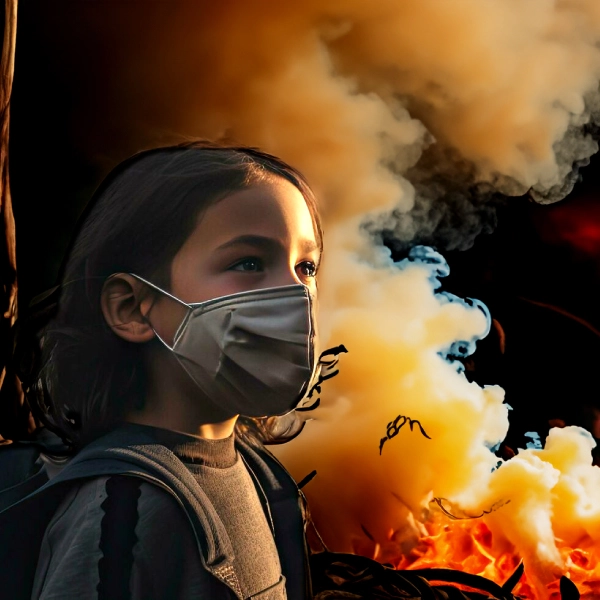Wildfires are a destructive force of nature, leaving a trail of ecological devastation in their wake. However, their impact extends beyond the scorched earth and damaged ecosystems; wildfires also threaten human health. In this comprehensive look into the health effects of wildfire smoke, our primary focus will be on one of the most distressing symptoms: headaches. Headaches may seem trivial in the face of widespread destruction, but they often indicate more profound health issues. The toxic components within the smoke cause these headaches, and understanding them requires an in-depth exploration.
The technology to detect and study these harmful components has advanced in recent years. Notably, Oizom has developed advanced and accurate air quality monitors, which are instrumental in researching and combating the harmful effects of wildfire smoke. Oizom’s air quality monitoring systems allow for real-time air quality monitoring, providing invaluable data to communities, governments, and healthcare providers.
The implications of the findings from these monitors reach into various aspects of environmental protection, public health policy, and personal well-being. Therefore, this data is not merely academic but an urgent and practical guide to understanding the dire consequences of wildfire smoke.
Health Effects of Wildfire Smoke
The symptoms below form a complex web of health concerns stemming from exposure to wildfire smoke. Understanding these symptoms and their underlying causes is the first step in formulating effective responses at the individual and community levels.
Coughing and Throat Irritation
When wildfire smoke invades the air we breathe, it carries a mixture of gases and fine particles from burning trees and plants. These can irritate the lungs and throat, causing coughing and throat irritation. People with asthma or chronic bronchitis may experience more severe reactions, leading to more significant health issues. For example, consistent exposure to these irritants can exacerbate existing respiratory conditions and contribute to chronic respiratory diseases.
Runny or Stuffy Nose
Our bodies are well-equipped to deal with harmful substances, but the sheer volume of irritants in wildfire smoke can overwhelm these defences. This can lead to symptoms like a runny or stuffy nose as the body tries to flush out or block the harmful particles. The reaction varies from person to person, with some experiencing mild discomfort while others may suffer from more severe symptoms, particularly those with allergies or other underlying health conditions.
Shortness of Breath
The particulate matter in wildfire smoke can penetrate the lungs, leading to shortness of breath. This is more than a mere inconvenience; it can be a terrifying experience, particularly for those with pre-existing respiratory conditions like asthma or COPD. The shortness of breath can lead to decreased oxygen levels in the body, posing a significant health risk. The long-term implications include a higher risk of heart attacks and other cardiovascular problems.
Eye Irritation
The eyes are particularly sensitive to the chemicals in wildfire smoke, resulting in irritation. In extreme cases, this can manifest as stinging, redness, or even temporary vision loss. Prolonged exposure without proper protection can result in lasting eye damage, emphasising the need for proper safety measures.
Headaches
Headaches caused by wildfire smoke are more than mere annoyances; they can indicate more severe health problems. The toxic substances in the smoke can cause inflammation in the body, leading to persistent headaches. Those suffering from migraines or other chronic headache conditions may find their symptoms exacerbated by exposure to wildfire smoke.
Role of Specific Chemicals in Causing Headaches
Aldehydes
Aldehydes are organic compounds found in wildfire smoke and are one of the primary irritants responsible for headaches. They interact with the sensitive tissues in the eyes and respiratory system, leading to discomfort and pain. Their presence in wildfire smoke can also aggravate existing medical conditions, such as asthma and bronchitis, making the symptoms more pronounced and challenging to manage.
Acid Gases
Acid gases like hydrochloric acid and acetic acid are byproducts of burning materials in wildfires. These acidic compounds can irritate the mucous membranes in the nose, throat, and eyes, often leading to headaches. The inflammation they cause can have long-term health effects if exposure is not managed and mitigated properly.
Sulphur Dioxide
Sulphur dioxide (SO2) is another significant component of wildfire smoke that can have adverse health effects. Its inhalation can cause respiratory issues and headaches, with long-term exposure linked to chronic bronchitis and other respiratory diseases. This compound’s presence in the environment is also a concern, as it contributes to acid rain, furthering the environmental impact of wildfires.
Nitrogen Oxides
Wildfire smoke releases nitrogen oxides (NOx), which can react with other atmospheric chemicals to create smog. This affects air quality and causes respiratory irritation leading to headaches. Nitrogen oxides cause airway inflammation and can exacerbate conditions like asthma and bronchitis.
Carbon Monoxide
One of the most dangerous chemicals in wildfire smoke is carbon monoxide (CO). It is colourless and odourless, making it particularly insidious. Inhalation of CO can cause headaches, dizziness, and confusion. In more severe cases, it can lead to unconsciousness or even death. Understanding the role of these specific chemicals in terms of individual health and broader environmental effects is critical for addressing the problem at its core.
Personal Protective Measures to Reduce Exposure to Wildfire Smoke
Personal protective measures are advisable and essential in an era of increasing wildfires. These include:
- Staying Indoors: Keeping windows and doors closed during a wildfire can minimise exposure to harmful smoke.
- Using Air Purifiers: Devices that filter particles from the air can help keep indoor air clean.
- Wearing Masks: Respiratory masks can filter out particles and provide protection outdoors.
Monitoring Air Quality: Utilising Portable air quality monitors, such as those provided by Oizom, can give real-time information about air quality, allowing for informed decisions. Oizom’s monitors are designed to detect even trace amounts of harmful compounds, enabling users to take proactive measures.
Government and Community Interventions to Improve Air Quality During Wildfires
Addressing the issue of air quality during wildfires requires a collective effort. The government, communities, and individuals must work together to mitigate the effects of wildfire smoke. Strategies include:
- Regulating Land Management: Governments can enforce strict land management practices to reduce the risk of wildfires.
- Air Quality Monitoring: Advanced air quality monitoring tools like those developed by Oizom can provide accurate and timely data, aiding in crisis response and long-term planning.
- Public Awareness Campaigns: Educating the public about the risks associated with wildfire smoke and promoting protective measures can broadly impact community health.
Wrapping Up
Wildfire smoke’s effects on human health, particularly in causing headaches, present a complex and pressing challenge. Events like Canada Wildfire Smoke highlight how widespread and severe the impact can be, underscoring the urgency to understand the chemicals involved and their interactions with the human body.
Personal protective measures, including advanced technology like Oizom’s air quality monitors, can empower individuals to take control of their exposure. However, the solution does not lie solely in personal responsibility. Government intervention, community engagement, and technological advancements must all be part of a comprehensive strategy to manage and mitigate the health risks associated with wildfire smoke.
For a future where both our environment and personal well-being are protected, we must act collectively. Oizom’s dedication to providing accurate air quality monitoring solutions represents a significant step in the right direction. We can create a healthier and more sustainable world by embracing these technologies and working together.
Explore Oizom’s air quality monitoring solutions today to protect your community from the adverse effects of wildfire smoke. Your actions can make a difference in building a safer environment for all.






